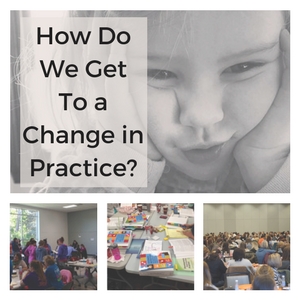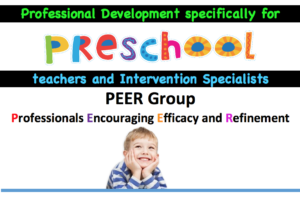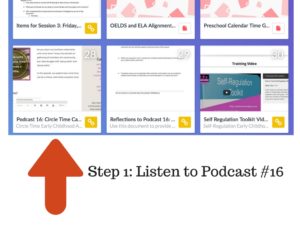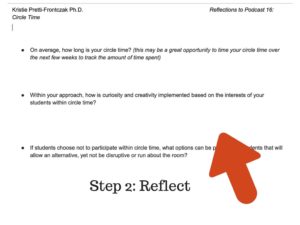 Ask just anyone who has designed, delivered, or attended a professional development and learning event what their hopes and desired outcomes are, and the answer will be the same. They want to see a change in practice!
Ask just anyone who has designed, delivered, or attended a professional development and learning event what their hopes and desired outcomes are, and the answer will be the same. They want to see a change in practice!
But how do we get to a change in practice?
Well, after my own searching, and somewhere near 50,000 hours of working with adults, I found that being guided by a single question has allowed me to get closer to the desired result of seeing a change in practice.
That guiding question?
“How can professional development and learning engage a teacher’s mind, body, and heart?”
This simple yet profound shift in the question I ask, as I design professional development and learning, makes all the difference. It ensures that I am guided by compassion and hope, and it ensures a dynamic approach to supporting adult learners. It’s also what lead to the development of the Pre-K Teach & Play website….a dedicated resource site, which includes free toolkits, training videos, infographics, printables and a variety of other social tools, from blogs to podcasts, for my community of ECE {r}evolutionaries.
And like me, there are many other ECE leaders around the U.S., working to embrace this approach to professional development and learning. An approach that ensures teachers work from a place of wholeness, wonder, and intentionality.
It is the stories of these ECE leaders that I share with you in this blog post.
Specifically, I share six case examples of ECE leaders who are using the resources found on the Pre-K Teach & Play website to design and deliver professional development that engages the mind, body, and heart of their staff and colleagues. We begin with the work of ECE leader, Michael Coppa, M.S., Principal, Mary L. Evans Early Childhood Center and Testing Coordinator for North Canton City Schools in North Canton, OH.
Michael has formed what he calls a PEER Group, which stands for Professionals Encouraging Efficacy and Refinement. The PEER group is comprised of five preschool teachers working in North Canton City Schools and throughout Stark County, Ohio.

Michael’s goals for the PEER Group are to:
- Empower preschool teachers in the quest to support the social and emotional needs of children
- Further develop instructional strategies in the classroom
- Provide a network opportunity for preschool teachers to share resources for the advancement of their professional growth
The PEER Group is built upon a hybrid learning format where teachers have the ability to access and discuss resources through an online platform as well as meet face-to-face. For the online portion, Michael uses TES Teach, which is a free space for creating lessons, presentations, and projects. Michael also meets monthly with teachers, who often bring student work samples and first-hand experiences to the PEER Group gatherings as a means of ongoing collaboration and problem solving.
Examples of resources posted to TES Teach, and explored by teachers from the Pre-K Teach & Play website, include the “Teach Before the Peak” video and the Self-Regulation Toolkit.
Click HERE for a guide Michael created when first designing the PEER Group. The planning form was used as his guide to connect Pre-K Teach & Play resources to quality indicator standards, Ohio’s Educator’s Standards.
One of the first “assignments” of the PEER Group, was to have teachers upload a 360° panoramic picture of their classroom. The teachers then discussed online, the extent to which the physical and social environments met the needs of the children being served, promoted developmentally appropriate practices, and how the environment supported intentional learning for all students.


The online discussions from the 360° classroom photos, lead to a f2f discussion about circle time, which in turn, led Michael to post the Pre-K Teach & Play Podcast, titled, “Circle Time Can Be a Choice” to the online space (see image).
Teachers were then asked to listen to the podcast and reflect on a few guiding questions (see image).

To date, the PEER Groups have lead to “ah-ha moments” as tales are shared and staff realize that they’re not alone. By describing some of their ‘classroom episodes’ and as a collaborative, the group is able to assist those through developmentally appropriate strategies as a means to assist.

A note from Michael Coppa (coppam@northcantonschools.org)
For me, my role as an academic leader is to build upon teacher passion, be intention with the professional development offered, and recognize the uniqueness of the adult learner. Academic leaders can start by identifying the needs of their staff, just as we seek the interests and needs of students (and continue to monitor their progress accordingly). Additionally, leaders can provide staff members the opportunity to collaborate with one another through professional development where communication and ownership are cultivated. Our PEER group, specifically, is becoming more authentic and augmented to magnify teacher needs through discussion and resources. Our vision is to continue this next year while continuing to bring in new members (those new to the field as well as veteran teachers) who want to enhance their instructional approach while providing the best opportunities for students to succeed. One of the integrated components we continue to address is having a growth mindset regarding instructional approach. So often, past practice is not best practice. Additionally, we often ‘adopt’ what our predecessors have bestowed us within our classrooms merely because, ‘it’s what we have always done.’ What works with one class, may not be the same for all. Or what works this week, may not work next week when 1 or 2 new students enter the learning environment. Challenging teachers to be reflective within their practices while supporting the needs of their students (a focus for learning and the environment of which students thrive) is something we revisit on a continual basis.